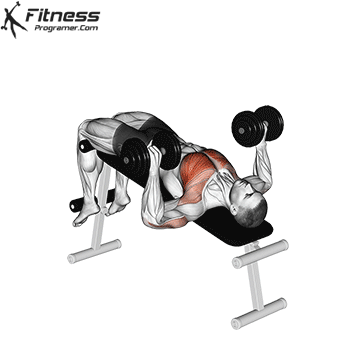Decline Barbell Bench Press Overview
The decline barbell bench press is a chest-focused pressing exercise performed on a decline bench set at an angle of approximately 15 to 30 degrees. This variation of the bench press places greater emphasis on the lower pectoralis major, helping to build mass, strength, and muscle definition in the chest.
How to Perform a Decline Barbell Bench Press
Step-by-Step Guide
Setup:
- Adjust a decline bench to an angle of 15 to 30 degrees.
- Lie down and secure your feet under the foot pads to maintain stability.
Grip and Positioning:
- Grab the barbell with an overhand grip, hands slightly wider than shoulder-width apart.
- Unrack the barbell and hold it with arms fully extended above your chest.
Lowering Phase:
- Slowly lower the barbell toward your lower chest, keeping your elbows at about a 45-degree angle.
- Lower until the bar lightly touches your chest without bouncing.
Pressing Phase:
- Push the barbell back up in a controlled motion until your arms are fully extended.
- Engage your chest, shoulders, and triceps to complete the lift.
Repeat:
- Perform 3 to 5 sets of 6 to 12 reps, depending on your training goals.
Tips for Proper Form
- Keep your wrists straight and avoid excessive bending to prevent injury.
- Maintain core engagement to stabilize your body throughout the movement.
- Avoid bouncing the bar off your chest as this reduces effectiveness and increases injury risk.
- Use a spotter if lifting heavy weights to ensure safety.
- Exhale as you press up and inhale as you lower the bar.
Common Mistakes to Avoid
- Arching the Back Excessively: Maintain a neutral spine to prevent strain on the lower back.
- Improper Grip Width: A grip that is too narrow or too wide can limit effectiveness and cause wrist or shoulder strain.
- Rushing the Movement: Lower and press the bar with control to maximize muscle engagement.
- Lifting Too Heavy Too Soon: Start with moderate weight to perfect your form before increasing resistance.
- Lack of Full Range of Motion: Failing to lower the bar to the chest reduces the effectiveness of the exercise.
Benefits of the Decline Barbell Bench Press
1. Builds a Stronger and More Defined Lower Chest
This exercise specifically targets the lower pectoral muscles, enhancing lower chest shape and definition.
2. Increases Overall Pressing Strength
By working triceps, shoulders, and chest, the decline bench press helps improve pressing power for other lifts like the flat and incline bench press.
3. Reduces Shoulder Strain
Compared to the flat and incline bench press, the decline variation puts less stress on the shoulders, making it a safer option for individuals with shoulder discomfort.
4. Enhances Muscle Activation
Studies show that the decline bench press activates the lower pecs more effectively than the flat bench, leading to greater chest development.
5. Supports Functional Strength
Pressing movements translate to improved pushing strength, benefiting athletic performance and daily activities.
How to Incorporate Into Your Routine
- Chest-Focused Workouts: Perform 3 to 4 sets of 6 to 12 reps to build muscle size and strength.
- Superset Training: Pair with flat or incline presses for full chest development.
- Progressive Overload: Gradually increase weight or reps to continue making strength gains.
- Variation: Alternate with dumbbell decline press to improve muscle activation and stability.
Decline Barbell Bench Press Muscles Worked



